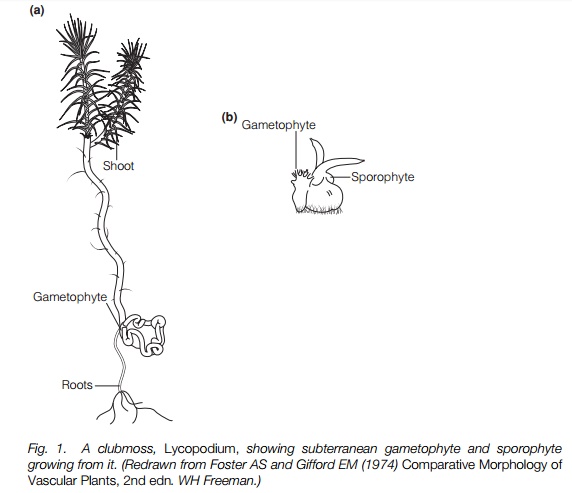Chapter: Plant Biology : Spore bearing vascular plants
Reproduction and Gametophyte in Lycopsida
Reproduction in Lycopsida
One group of Lycopsida, including about 200 species of Lycopodium and its relatives, is homosporous; the other two groups, Selaginella (about 700 species) and Isoetes (about 70 species) are heterosporous . In all groups the sporangia are produced singly in the axils of leaves. In a few homosporous species there are fertile sections of the stem but in most there are separate strobili (singular strobilus). These consist of specialized scale-like microphylls with a different morphology from the vegetative leaves, often raised above the main stem. Nearly all Selaginella species have strobili and in Isoetes all leaves may bear sporangia.
The sporangium is normally 1–2 mm across, though larger in Isoetes. The sporangium consists of a wall, initially of several cell layers, though the inner layers break down as the spores mature. It dehisces along a line of thin-walled cells. In the heterosporous groups, strobili may contain a mixture of male sporangia and female sporangia, often with female at the base, or bear them in separate strobili. In the male sporangia, or microsporangia, there are numerous microspores, in Isoetes possibly as many as one million. In megasporangia of Selaginella there is usually one spore mother cell undergoing meiosis to produce four megaspores, though a few species may produce eight or more. In Isoetes more than 100 megaspores are produced in each sporangium.

Gametophyte of Lycopsida
In homosporous forms two types of gametophyte are known, both independent multicellular structures (Fig. 1). One type is cylindrical to 3 mm long and grows near the soil surface, becoming green and branched in the light, with sex organs, usually mixed, at the base of the branches. It lives for up to 1 year. The second type is subterranean or epiphytic and may live for 10 years before reaching 2 cm in length. It is oblong, disc-like or branched and antheridia are produced first in the center, while archegonia are produced later towards the edge. All areinfected with fungi that occupy a defined place and are essential for nutrition of the gametophyte and act as mycorrhizae do in angiosperms .
In heterosporous groups the gametophyte is much reduced and develops entirely within the spore wall, beginning development before leaving the sporangium. In microspores the first cell division leads to one vegetative cell known as the prothallus cell, and a second cell which divides to form the antheridium. The antheridium consists of a sterile jacket, but this and the prothallus cell disintegrate at maturity. In Selaginella biflagellate sperms, usually 128 or 256, all contained within the spore, are produced; in Isoetes just four multiflagellate sperms are produced. By this time the microspore has dispersed. The spore wall ruptures to release the sperms. In the megaspore, a gametophyte of many cells grows and the spore wall ruptures. Archegonia similar to those of bryophytes grow by the break. Dispersal of the female gametophyte occurs at different times in different species but in a few species it is retained until after fertilization and the embryo is growing.
Related Topics